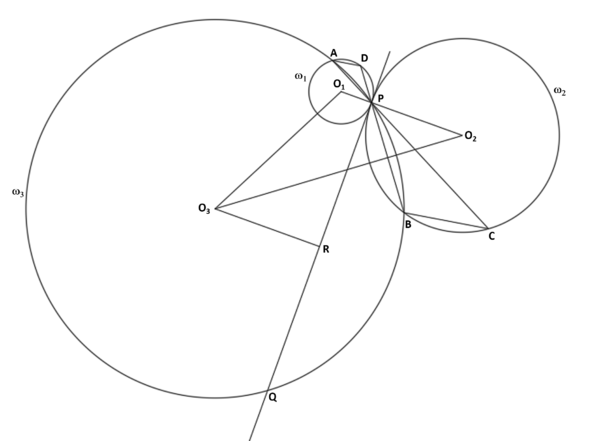Difference between revisions of "Mock AIME 3 Pre 2005 Problems/Problem 14"
| (14 intermediate revisions by the same user not shown) | |||
| Line 3: | Line 3: | ||
==Solution== | ==Solution== | ||
| + | |||
| + | [[File:AIME_2005_14a.png|600px]] | ||
Let <math>O_1, O_2,</math> and <math>O_3</math> be the centers of <math>\omega_1, \omega_2</math> and <math>\omega_3</math> respectively. | Let <math>O_1, O_2,</math> and <math>O_3</math> be the centers of <math>\omega_1, \omega_2</math> and <math>\omega_3</math> respectively. | ||
| − | Let point <math>R</math> be the midpoint of <math>QP</math>. Thus, <math>O_3R \bot PQ</math> and <math>|PR|=\frac{| | + | Let point <math>R</math> be the midpoint of <math>QP</math>. Thus, <math>O_3R \bot PQ</math> and <math>|PR|=\frac{|PQ|}{2}=16</math> |
Let <math>r_1</math> and <math>r_2</math> be the radii of circles <math>\omega_1</math> and <math>\omega_2</math> respectively. | Let <math>r_1</math> and <math>r_2</math> be the radii of circles <math>\omega_1</math> and <math>\omega_2</math> respectively. | ||
| Line 14: | Line 16: | ||
Since <math>O_3R \parallel O_1O_2</math> and <math>\angle RO_3O_2 = \angle O_3O_2O_1</math>, then <math>O_2B \parallel O_1D</math>, and <math>BC \parallel AD</math> | Since <math>O_3R \parallel O_1O_2</math> and <math>\angle RO_3O_2 = \angle O_3O_2O_1</math>, then <math>O_2B \parallel O_1D</math>, and <math>BC \parallel AD</math> | ||
| − | This means that <math>\Delta PDA \sim \Delta PBC \sim \Delta | + | This means that <math>\Delta PDA \sim \Delta PBC \sim \Delta O_3O_1O_1</math>. In other words, those three triangles are similar. |
Since <math>r_1</math> is the circumcenter of <math>\Delta PDA</math>, | Since <math>r_1</math> is the circumcenter of <math>\Delta PDA</math>, | ||
| Line 24: | Line 26: | ||
Then, <math>A_1=\frac{|AD| \times h_1}{2}</math>, thus <math>h_1=\frac{2}{3}A_1</math> | Then, <math>A_1=\frac{|AD| \times h_1}{2}</math>, thus <math>h_1=\frac{2}{3}A_1</math> | ||
| − | + | Since <math>PR</math> is the height of <math>\Delta O_1O_2O_3</math> to side <math>O_1O_2</math>, then using similar triangles, | |
| − | Therefore, <math>\frac{r_1+r_2}{16}=\frac{3}{\frac{2}{3}A_1}</math> | + | <math>\frac{|O_1O_2|}{|PR|}=\frac{|AD|}{h_1}</math>. Therefore, <math>\frac{r_1+r_2}{16}=\frac{3}{\frac{2}{3}A_1}</math>. Solving for <math>r_2</math> we have: |
<math>r_2=\frac{72}{A_1}-r_1=\frac{72}{A_1}-\frac{18}{A_1}=\frac{54}{A_1}=3\left( \frac{18}{A_1} \right)=3r_1</math> | <math>r_2=\frac{72}{A_1}-r_1=\frac{72}{A_1}-\frac{18}{A_1}=\frac{54}{A_1}=3\left( \frac{18}{A_1} \right)=3r_1</math> | ||
| + | By similar triangles, | ||
| + | |||
| + | <math>A_2=\left( \frac{r_2}{r_1} \right)^2A_1=9A_1</math> | ||
| + | |||
| + | Using Heron's formula, | ||
| + | |||
| + | <math>A_1=\sqrt{s(s-a)(s-b)(s-c)}</math>, where <math>s=\frac{a+b+c}{2}=\frac{3+6+4}{2}=\frac{13}{2}</math> we have: | ||
| + | <math>A_1=\sqrt{\left( \frac{13}{2} \right)\left( \frac{13}{2}-3\right)\left( \frac{13}{2}-6 \right)\left( \frac{13}{2}-4 \right)}</math> | ||
| + | <math>A_1=\frac{\sqrt{\left(13\right)\left(7\right)\left(1\right)\left(5\right)}}{4}=\frac{\sqrt{455}}{4}</math> | ||
| − | + | <math>A_2=9A_1=\frac{9\sqrt{455}}{4}=\frac{p\sqrt{q}}{r}</math>, thus <math>p=9,q=455,r=4</math> | |
| + | |||
| + | <math>p+q+r=\boxed{468}</math> | ||
~Tomas Diaz. orders@tomasdiaz.com | ~Tomas Diaz. orders@tomasdiaz.com | ||
| + | |||
| + | {{alternate solutions}} | ||
==See Also== | ==See Also== | ||
{{Mock AIME box|year=Pre 2005|n=3|num-b=13|num-a=15}} | {{Mock AIME box|year=Pre 2005|n=3|num-b=13|num-a=15}} | ||
Latest revision as of 01:05, 25 November 2023
Problem
Circles ![]() and
and ![]() are centered on opposite sides of line
are centered on opposite sides of line ![]() , and are both tangent to
, and are both tangent to ![]() at
at ![]() .
. ![]() passes through
passes through ![]() , intersecting
, intersecting ![]() again at
again at ![]() . Let
. Let ![]() and
and ![]() be the intersections of
be the intersections of ![]() and
and ![]() , and
, and ![]() and
and ![]() respectively.
respectively. ![]() and
and ![]() are extended past
are extended past ![]() and intersect
and intersect ![]() and
and ![]() at
at ![]() and
and ![]() respectively. If
respectively. If ![]() and
and ![]() , then the area of triangle
, then the area of triangle ![]() can be expressed as
can be expressed as ![]() , where
, where ![]() and
and ![]() are positive integers such that
are positive integers such that ![]() and
and ![]() are coprime and
are coprime and ![]() is not divisible by the square of any prime. Determine
is not divisible by the square of any prime. Determine ![]() .
.
Solution
Let ![]() and
and ![]() be the centers of
be the centers of ![]() and
and ![]() respectively.
respectively.
Let point ![]() be the midpoint of
be the midpoint of ![]() . Thus,
. Thus, ![]() and
and ![]()
Let ![]() and
and ![]() be the radii of circles
be the radii of circles ![]() and
and ![]() respectively.
respectively.
Let ![]() and
and ![]() be the areas of triangles
be the areas of triangles ![]() and
and ![]() respectively.
respectively.
Since ![]() and
and ![]() , then
, then ![]() , and
, and ![]()
This means that ![]() . In other words, those three triangles are similar.
. In other words, those three triangles are similar.
Since ![]() is the circumcenter of
is the circumcenter of ![]() ,
,
then ![]()
Let ![]() be the height of
be the height of ![]() to side
to side ![]()
Then, ![]() , thus
, thus ![]()
Since ![]() is the height of
is the height of ![]() to side
to side ![]() , then using similar triangles,
, then using similar triangles,
![]() . Therefore,
. Therefore, ![]() . Solving for
. Solving for ![]() we have:
we have:
![]()
By similar triangles,
![]()
Using Heron's formula,
![]() , where
, where ![]() we have:
we have:

![]()
![]() , thus
, thus ![]()
![]()
~Tomas Diaz. orders@tomasdiaz.com
Alternate solutions are always welcome. If you have a different, elegant solution to this problem, please add it to this page.
See Also
| Mock AIME 3 Pre 2005 (Problems, Source) | ||
| Preceded by Problem 13 |
Followed by Problem 15 | |
| 1 • 2 • 3 • 4 • 5 • 6 • 7 • 8 • 9 • 10 • 11 • 12 • 13 • 14 • 15 | ||










